Out of so many lead generation strategies, outbound lead generation is one of the most reliable and proactive ways to grow your business. It involves directly reaching out to potential customers instead of waiting for them to find you through inbound methods like blogs or social media.
Whether targeting specific industries or building a scalable sales pipeline, outbound lead generation provides the tools and strategies to connect with prospects efficiently.
This comprehensive guide explores what is outbound lead generation, its processes, tools, and strategies, and how businesses can use it to scale in 2024.
 Generate More Leads 24/7 With CallHippo AI Sales Agent
Generate More Leads 24/7 With CallHippo AI Sales AgentA well-defined ICP allows sales teams to focus on prospects that are more likely to convert, improving efficiency and ROI.
What is Outbound Lead Generation?
Outbound lead generation is a proactive sales approach where businesses initiate contact with potential customers rather than waiting for them to engage. This method often involves reaching out through cold calls, emails, social media, or other direct communication methods to identify and nurture outbound leads. Unlike inbound methods that rely on content to attract leads, outbound ensures you’re consistently taking action to find new prospects.
Outbound strategies are an integral part of your organization because they allow businesses to:
Outbound strategies are an integral part of your organization because they allow businesses to:
- Target specific demographics or industries with precision.
- Generate immediate engagement and feedback.
- Create predictable sales pipelines that can be scaled as needed.
How Does Outbound Lead Generation Work?
Outbound lead generation revolves around identifying, engaging, and nurturing leads to convert them into paying customers. It involves proactive strategies like cold calling, email outreach, and social media engagement to initiate conversations with potential clients. By tailoring messages to address specific pain points, businesses can build trust, foster relationships, and guide leads through the sales funnel effectively.
Key Components of the Outbound Lead Generation Process
The outbound lead generation process is structured around key steps to ensure efficiency and success:
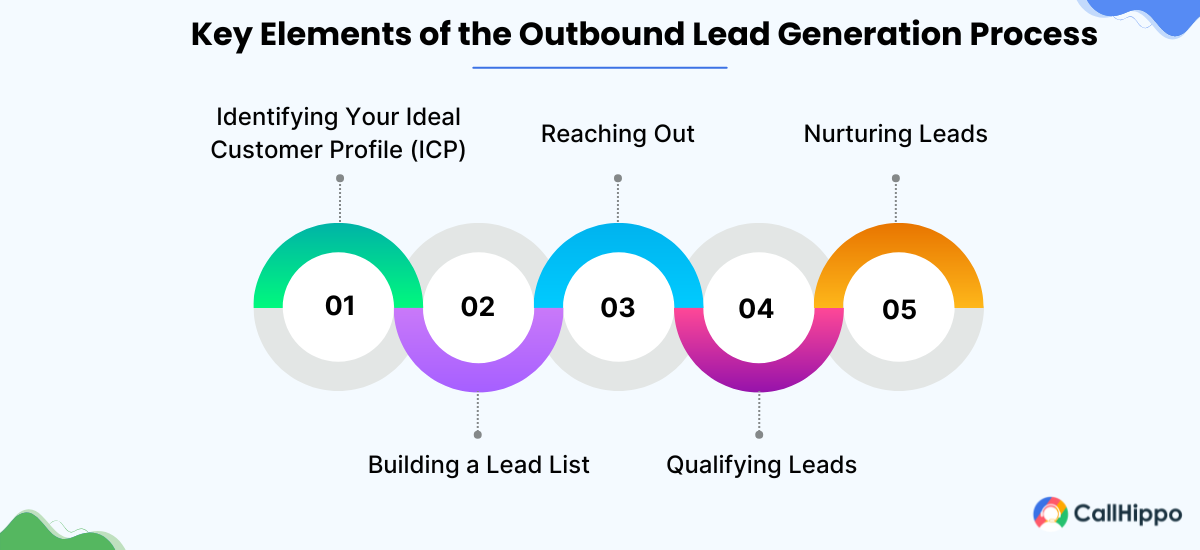
1. Identifying Your Ideal Customer Profile (ICP)
Defining your ICP is the foundation of any successful outbound lead generation strategy. An ICP outlines the type of customers most likely to benefit from your product or service. It includes demographics, firmographics (e.g., company size, industry), pain points, and buying behaviors.
For example, if you sell B2B SaaS solutions, your ICP might be mid-sized companies in the technology sector struggling with workflow automation.
2. Building a Lead List
Once the ICP is clear, you need a list of prospects who fit this profile. This list can be built internally through research, social media, and tools like LinkedIn Sales Navigator or purchased from third-party vendors specializing in lead data. Ensure the data is accurate, up-to-date, and compliant with data privacy regulations like GDPR or CCPA.
3. Reaching Out
Outbound lead generation relies on personalized outreach to capture attention. Common communication methods include:
- Well-crafted emails that address the prospect’s specific needs and pain points.
- Direct conversations to pitch your solution and gauge interest.
- Platforms like LinkedIn are often used to send connection requests and initiate discussions.
Personalization is critical here. Prospects are more likely to engage with messages tailored to their unique challenges and goals.
4. Qualifying Leads
Not all prospects will be a good fit or ready to buy. Lead qualification is the process of assessing whether a lead has a genuine interest and aligns with your ICP. This can be done by asking questions to understand their pain points, budget, decision-making authority, and timeline.
For example, using frameworks like BANT (Budget, Authority, Need, Timeline) or CHAMP (Challenges, Authority, Money, Prioritization) can help prioritize high-quality leads.
5. Nurturing Leads
Most leads won’t convert on the first interaction. Following up is essential to keep your product or service top-of-mind. Nurturing campaigns involve sending valuable content, reminders, or offers to move the lead closer to making a purchase decision. These can include:
- Follow-up emails sharing case studies or success stories.
- Offering a demo or consultation call.
- Addressing objections and providing answers to common questions.
Consistency and persistence in follow-ups are key to improving conversion rates.
Differences Between Outbound and Inbound Lead Generation
While outbound involves direct outreach, inbound focuses on attracting leads organically through content and SEO strategies. Outbound methods offer immediate results, while inbound is often slower but builds long-term credibility. For businesses looking to scale quickly, combining both approaches can be highly effective. Both methods can be combined for a well-rounded lead-generation strategy.
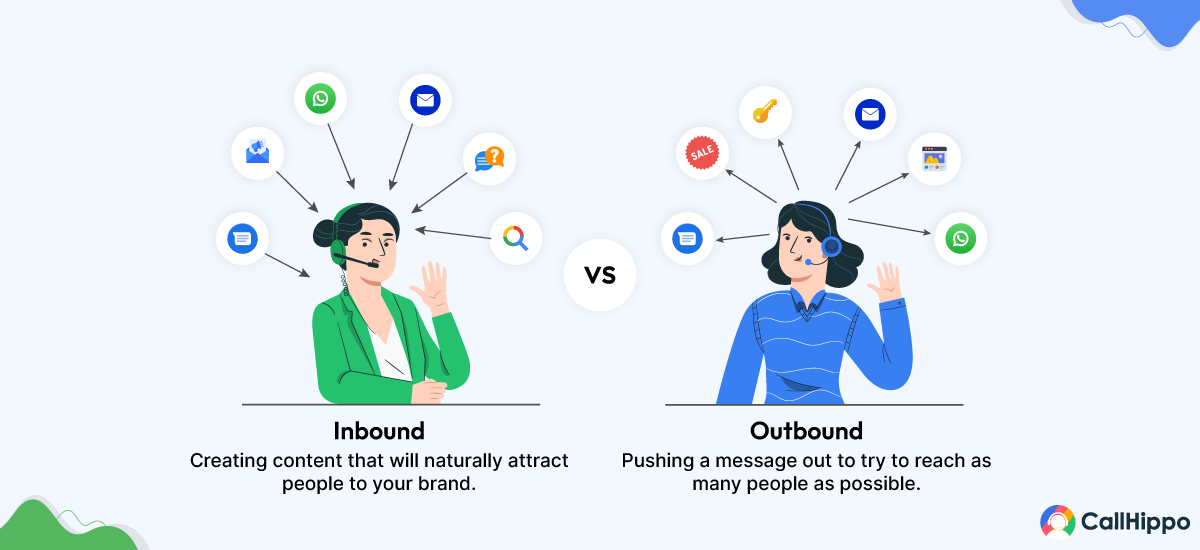
Why is Outbound Lead Generation Crucial for Businesses?
Outbound lead generation remains essential because it enables businesses to target their ideal audience directly and bypass waiting for leads to engage with them.
Benefits of Outbound Lead Generation
Its structured and proactive nature delivers several key advantages, including scalability, predictable ROI, and the ability to deliver personalized outreach. Below is a detailed exploration of these benefits.
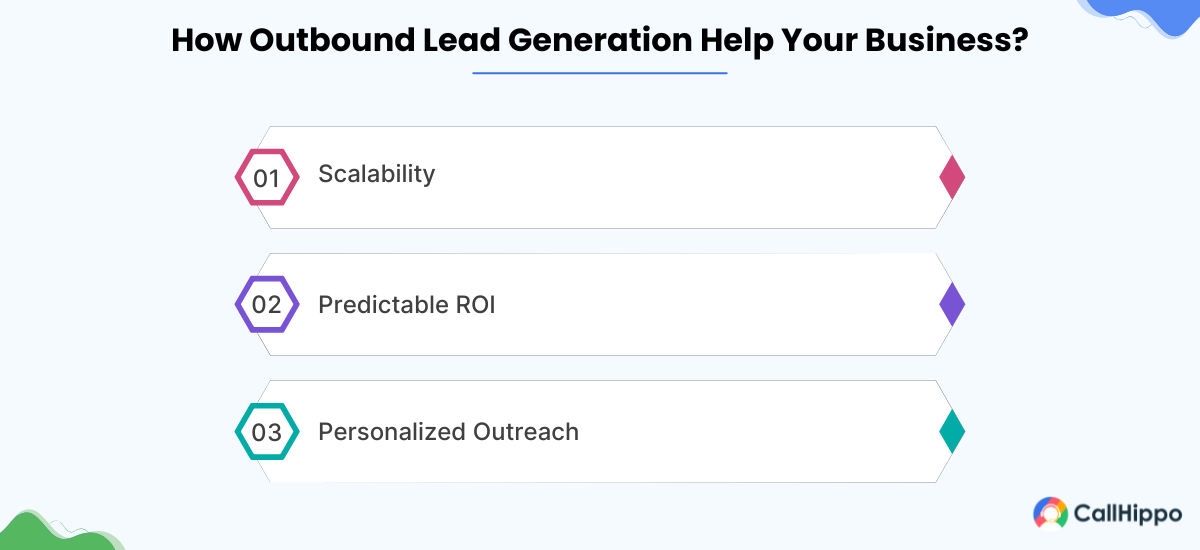
1. Scalability
Outbound lead generation is highly scalable, making it perfect for businesses aiming to grow quickly. You can expand your outreach by targeting more people, exploring new markets, or simply increasing the number of calls or emails sent. This proactive approach ensures a steady flow of leads, no matter how much your business grows.
With tools like CRM software and automation, scaling becomes manageable and efficient. Whether you’re a small business testing the waters or a large company aiming for global markets, outbound campaigns allow you to adjust your efforts as needed while keeping your sales pipeline full and productive.
2. Predictable ROI
Outbound lead generation provides a clear and measurable return on investment (ROI). You can track exactly how many leads were generated, how much each lead costs, and the revenue they bring in. This predictability makes it easier to plan budgets and fine-tune strategies for better results.
By analyzing metrics like conversion rates and campaign performance, you know what’s working and what isn’t. This data-driven approach means businesses aren’t just guessing—they’re making informed decisions that drive consistent results. Ultimately, outbound lead generation gives you the confidence to invest in growth, knowing you can measure and improve your outcomes.
3. Personalized Outreach
With outbound lead generation, businesses can connect with prospects in a way that feels personal and relevant. By using data like a prospect’s industry, role, or challenges, companies can craft messages that truly resonate.
For example, a cold email addressing a specific pain point or a tailored pitch during a call shows the prospect you understand their needs. This level of personalization not only grabs attention but also builds trust, making leads more likely to engage.
When prospects feel like you’re speaking directly to them, they’re more willing to continue the conversation, improving your chances of closing the deal.
Success Stories Showcasing ROI
Numerous companies have leveraged outbound lead generation services to achieve exponential growth. A compelling example of the outbound sales success story is Outreach.io, a leading sales engagement platform. The company implemented a robust outbound sales strategy using targeted account-based marketing (ABM).
They achieved over $60 million in revenue and secured a valuation exceeding $1.1 billion. Also improved customer acquisition rates through customer feedback loops, community building, and product innovation.
Top Outbound Lead Generation Strategies to Drive Sales
The key to successful outbound lead generation lies in using the right strategies. Below are the most effective approaches for generating high-quality outbound leads in 2024:
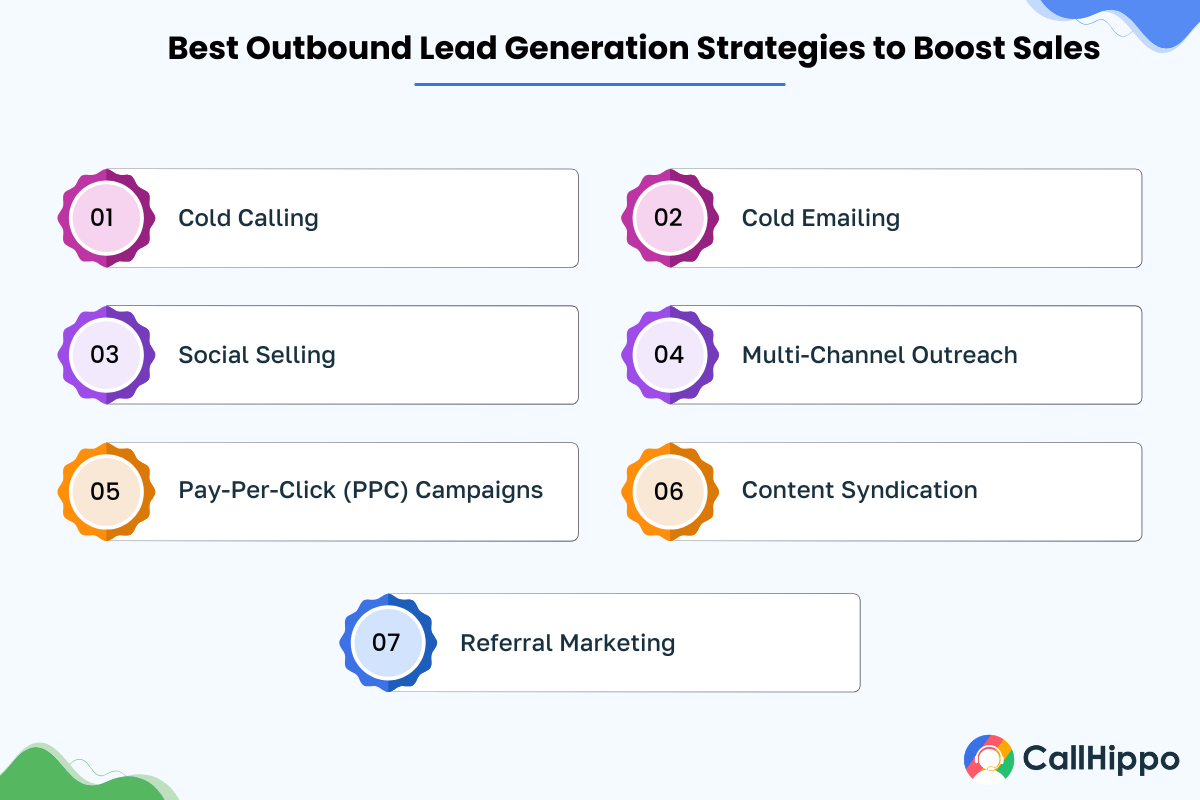
1. Cold Calling
Cold calling is a classic outbound lead generation strategy where sales representatives directly contact prospects over the phone to present products or services. While it may seem old-school, it remains highly effective when executed strategically. The key to success lies in thorough research—understanding the prospect’s business needs and challenges.
Personalize the conversation by addressing specific pain points and proposing tailored solutions rather than offering generic sales pitches. Cold calling works best when paired with a follow-up system, ensuring continuous engagement. With persistence and preparation, cold calling can help generate high-quality outbound leads and foster meaningful connections with potential clients.
2. Cold Emailing
Cold emailing is a go-to strategy for B2B outbound lead generation, offering a cost-effective and scalable way to reach prospects. Success in this approach hinges on crafting short, personalized emails with a clear value proposition.
Start with a subject line that grabs attention and sets the tone. In the email body, address the prospect’s needs, showcase social proof like client success stories, and highlight how your solution can help them. End with a strong call-to-action (CTA), inviting a response or meeting. When used thoughtfully, cold emailing can spark conversations and nurture leads into long-term business relationships.
3. Social Selling
Social selling leverages platforms like LinkedIn, Twitter, and Facebook to engage prospects and build relationships. Unlike traditional sales approaches, social selling focuses on connecting with prospects by sharing valuable content, participating in industry discussions, and offering insights rather than directly pitching a product.
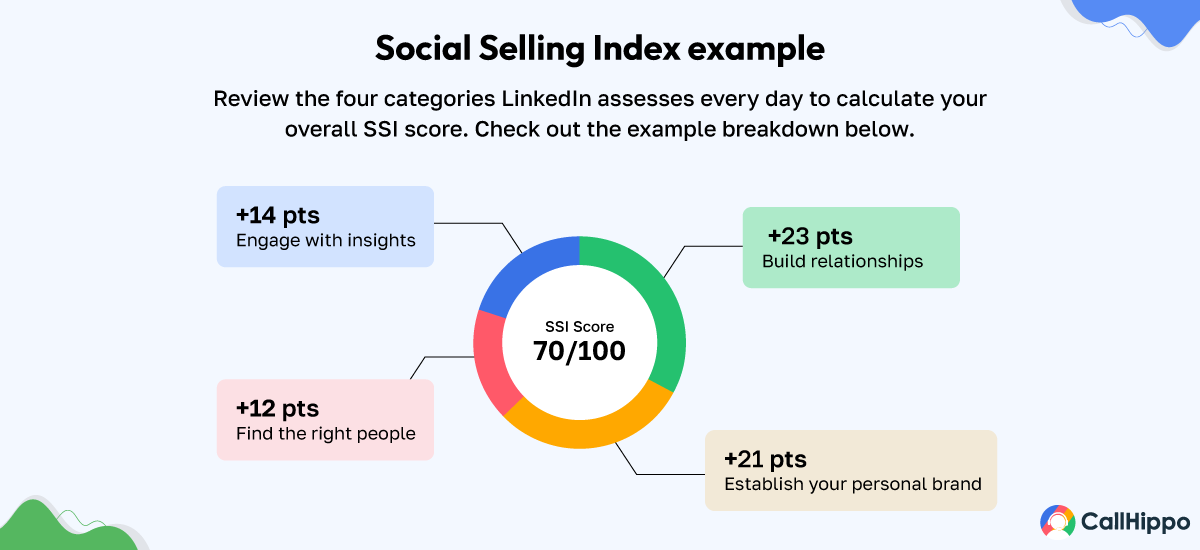
For instance, on LinkedIn, you can interact with prospects by commenting on their posts or joining relevant groups. Once trust is established, you can introduce your solution as a way to address their pain points. Social selling humanizes the sales process, making it a highly effective method for outbound lead generation in today’s digital age.
4. Multi-Channel Outreach
Multi-channel outreach combines various communication methods—such as emails, phone calls, LinkedIn messages, and even SMS—to connect with prospects more effectively. This approach ensures that you reach potential customers where they are most active and increases the likelihood of a response.
For example, you might send a cold email followed by a LinkedIn connection request and then schedule a phone call. A coordinated strategy across multiple channels creates a seamless experience for prospects and ensures consistent engagement. By diversifying outreach efforts, businesses can enhance their chances of generating outbound sales leads and closing deals faster.
5. Pay-Per-Click (PPC) Campaigns
While PPC campaigns are typically associated with inbound marketing, they can complement outbound lead generation strategies effectively. Targeted PPC ads on platforms like Google or LinkedIn help identify potential prospects based on demographics, job roles, or interests.
Once leads click on the ad, businesses can incorporate them into outbound efforts through personalized emails or follow-up calls. PPC campaigns are particularly useful for reaching niche audiences who might not be actively searching for solutions. By integrating PPC into your outbound strategy, you can create a hybrid approach that amplifies both visibility and lead generation.
6. Content Syndication
Content syndication involves distributing your content—such as blogs, whitepapers, or case studies—on third-party platforms to reach a broader audience. This strategy works well for outbound lead generation when paired with follow-up tactics.
For example, after prospects download your whitepaper from a syndicated site, your team can reach out via email or phone to start a conversation. The key is to ensure the content provides value and aligns with the prospect’s interests. Content syndication not only positions your business as a thought leader but also attracts high-intent leads, making it a powerful tool for outbound efforts.
7. Referral Marketing
Referral marketing is one of the most cost-effective and trusted methods of generating outbound leads. Satisfied customers can become brand advocates by referring your products or services to their peers or business networks. To encourage referrals, businesses can offer incentives such as discounts, cashback, or exclusive perks for successful recommendations.
Boost Outbound Lead Generation with CallHippo AI Sales Agents
AI tools have transformed the way businesses approach lead generation outbound campaigns
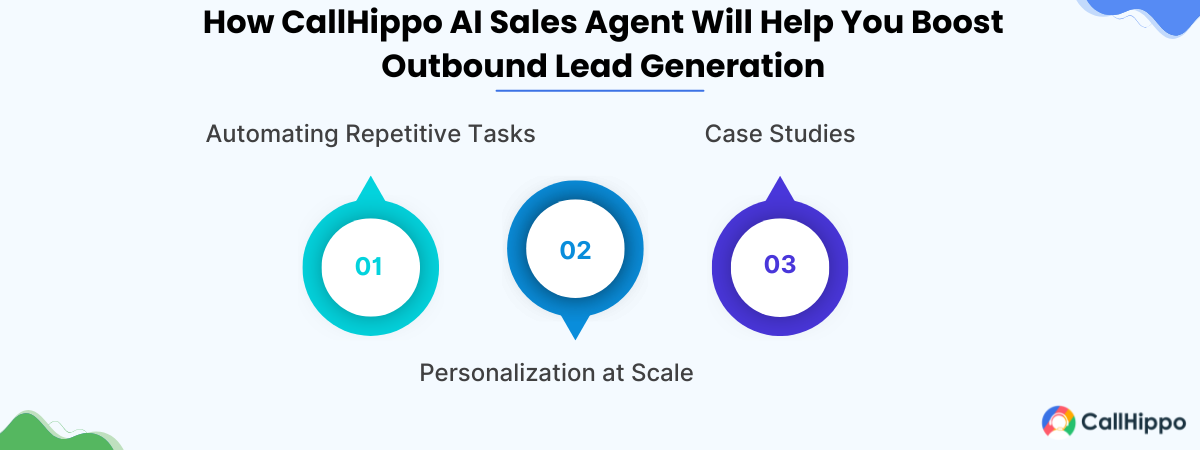
1. Automating Repetitive Tasks
AI tools have revolutionized the outbound lead generation process by automating time-consuming tasks like data entry, lead segmentation, email follow-ups, and appointment scheduling. These platforms free up sales teams to focus on more strategic activities, such as building relationships and closing deals. For example, AI can automatically update CRM systems or send follow-up emails based on predefined triggers, ensuring no lead falls through the cracks.
This not only improves efficiency but also reduces human error. By taking care of repetitive tasks, AI allows sales teams to allocate their time and energy to high-value activities, boosting overall agent productivity and results. Automation experts agree that AI can significantly reduce the time spent on manual processes, allowing teams to optimize their efforts on conversion-focused tasks.
2. Personalization at Scale
AI makes it easy to personalize outreach efforts for thousands of prospects at once, which is crucial for successful outbound lead generation strategies. It analyzes data like a prospect’s browsing history, industry, and preferences to create tailored messages that feel personal and relevant.
For instance, AI can send customized emails that address specific business challenges or offer solutions unique to their industry. This kind of targeted communication helps build trust and increases engagement rates. By scaling personalization, AI ensures every prospect feels valued, even in high-volume campaigns, which leads to better connections and higher chances of conversion.
3. Case Studies
AI’s effectiveness in outbound lead generation is best shown through real-life examples. Take a SaaS company, for instance, that was struggling to get responses from their email campaigns. They introduced an AI tool to handle email automation and personalized follow-ups. Within just three months, their response rates jumped by 25%.
The AI also took over scheduling calls and tracking interactions, saving the sales team hours of manual work. This example shows how AI doesn’t just improve efficiency—it also delivers measurable results, making it a game-changer for businesses looking to scale their outbound efforts.
with CallHippo AI Sales Agent
- Personalized pitches
- Multilingual flexibility
- Lead qualification
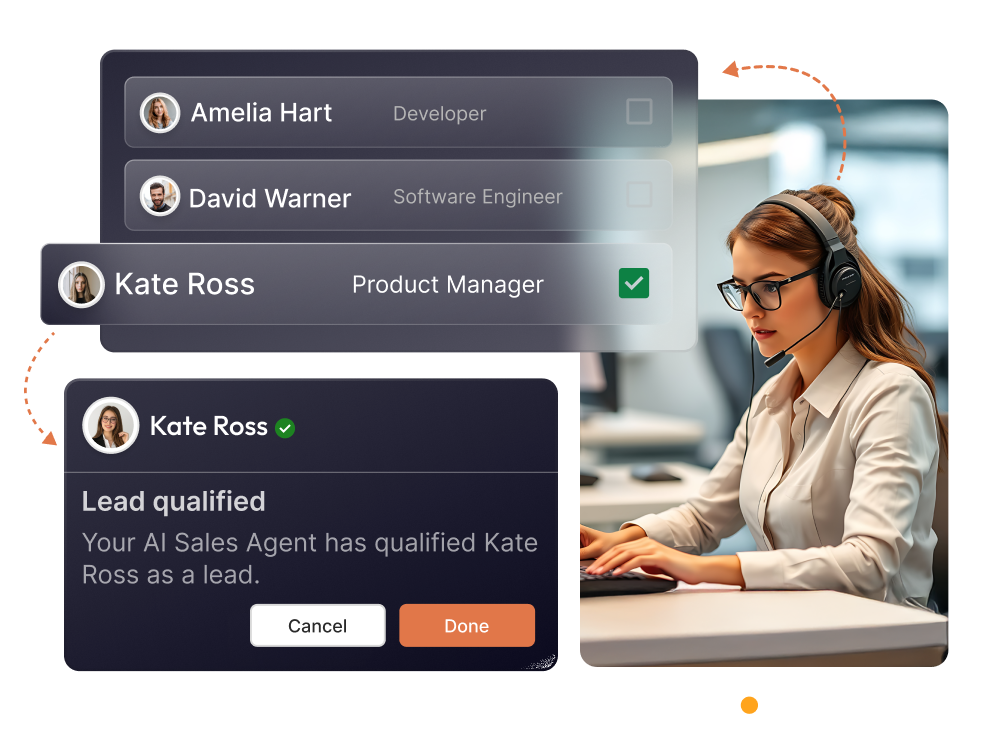
Step-by-Step Outbound Lead Generation Process
To achieve success in outbound lead generation, it’s important to follow a structured approach. Below are five steps that guide you from identifying prospects to closing deals, ensuring your efforts are focused and productive.
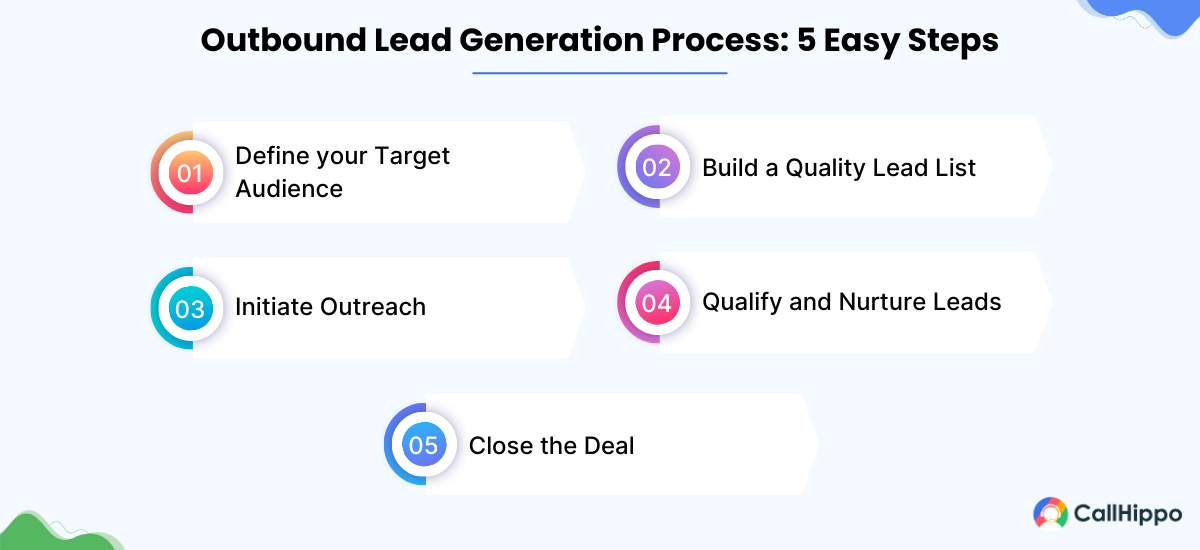
Step 1: Define your Target Audience
The first step in any successful outbound lead generation process is understanding who your ideal customers are. This involves analyzing demographics, job titles, industries, and pain points that align with your offering. For example, if your product targets HR professionals, focus on roles like HR managers or recruiters. Consider their challenges, such as improving employee engagement or streamlining hiring processes.
This detailed profiling ensures your outreach is relevant and resonates with your prospects. When you know exactly who you’re targeting, your messaging becomes more compelling, leading to higher engagement and better conversion rates. Industry experts like HubSpot recommend that businesses conduct in-depth buyer persona research to improve targeting accuracy.
Step 2: Build a Quality Lead List
Once you’ve identified your target audience, the next step is to create a high-quality list of potential leads. Use tools like LinkedIn Sales Navigator, Apollo, or trusted data providers to source accurate and relevant contact information. Verify and update your list to avoid outdated or incorrect details that waste time and effort. Include information such as job roles, email addresses, and company size to ensure targeted outreach.
A well-researched lead list forms the foundation of your outbound lead generation strategies, enabling you to focus your efforts on prospects most likely to convert into paying customers. Tools like Clearbit and ZoomInfo are known for providing enriched data that can refine your lead lists, ensuring more effective outreach.
Step 3: Initiate Outreach
With your lead list ready, it’s time to start reaching out. Whether it’s through personalized emails, cold calls, or social media messages, your outreach should address the specific challenges of your prospects. Begin with a strong introduction that grabs their attention, followed by a clear explanation of how your solution can help.
For instance, highlight measurable benefits like saving time or cutting costs. Personalization is key—generic pitches rarely succeed. By making your outreach relevant and engaging, you build trust and spark meaningful conversations that move prospects further along the sales funnel.
Step 4: Qualify and Nurture Leads
Not all leads are ready to buy immediately, so it’s essential to qualify them based on their budget, decision-making authority, need, and timing (BANT). Ask questions during calls or emails to determine whether they are a good fit for your solution.
Once qualified, nurture these leads by sharing valuable content like case studies, product demos, or educational webinars. Regular follow-ups ensure you stay top of mind as they progress through the decision-making process. This step bridges the gap between initial interest and conversion, turning potential customers into sales-ready leads.
Step 5: Close the Deal
The final step is converting your qualified leads into customers. Use a consultative approach to address any objections or concerns they may have. Highlight the ROI of your solution with data-backed examples, such as how it has helped similar businesses achieve their goals.
Be confident yet empathetic in your conversations, ensuring you understand their needs and how your product or service fulfills them. Closing the deal isn’t just about securing a sale—it’s about building a lasting relationship that fosters trust and loyalty. A well-executed close sets the stage for repeat business and referrals.
Tools to Boost Outbound Lead Generation
Several tools can significantly improve the efficiency and success of your outbound lead generation strategies. These tools help streamline processes, automate repetitive tasks, and provide deeper insights into your leads. Here’s how the most effective tools can boost your efforts.
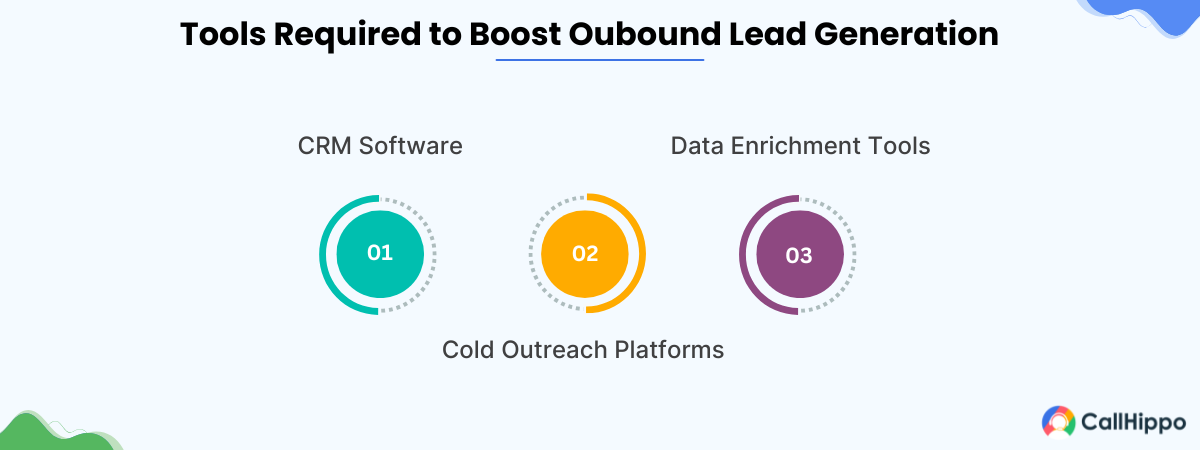
1. CRM Software
Customer Relationship Management (CRM) software is essential for managing interactions with leads and tracking outreach activities. It organizes contact information, monitors the progress of sales pipelines, and ensures no lead falls through the cracks. CRMs like HubSpot, Salesforce, or Zoho offer features such as lead scoring, task automation, and detailed analytics.
These tools also centralize data, making it easier for teams to collaborate and maintain consistent communication. By offering a complete view of your prospects’ journey, CRM software empowers businesses to optimize their outbound lead generation process and close deals more effectively. Leading experts recommend that businesses leverage CRM platforms with AI capabilities to further enhance lead nurturing and conversion rates.

2. Cold Outreach Platforms
Cold outreach platforms are designed to automate and simplify email and call campaigns. These tools help businesses send personalized emails or make scheduled calls at scale, saving time while maintaining a human touch. Popular options like SalesLoft, Outreach.io, and Mailshake allow users to create targeted campaigns, track engagement, and analyze performance metrics.
Features such as email templates, automated follow-ups, and call tracking to ensure consistent and efficient outreach efforts. By leveraging these platforms, businesses can engage with more prospects, improve response rates, and boost the effectiveness of their outbound sales lead generation campaigns.
3. Data Enrichment Tools
Data enrichment tools enhance the quality and accuracy of your lead data, making your campaigns more targeted and effective. These tools provide additional information about your prospects, such as job titles, industries, company sizes, and even recent activities.
Platforms like Clearbit, ZoomInfo, and Datanyze can integrate with CRMs and other tools to keep your lead database up to date.
Some of the most popular tools for outbound lead generation include HubSpot, a powerful CRM with automation capabilities; SalesLoft, which simplifies email and call outreach; and LinkedIn Sales Navigator, perfect for finding and engaging with high-quality leads.
Each of these tools offers unique features that align with different stages of the outbound lead generation process, helping businesses identify, nurture, and convert leads with ease. Choosing the right tools ensures a streamlined workflow, better targeting, and measurable results.
Metrics to Track for Outbound Lead Generation Success
Tracking the right metrics allows you to identify areas for improvement and fine-tune your efforts to ensure you’re targeting the right leads, reaching them effectively, and converting them into paying customers. Here are some of the key performance indicators (KPIs) to track
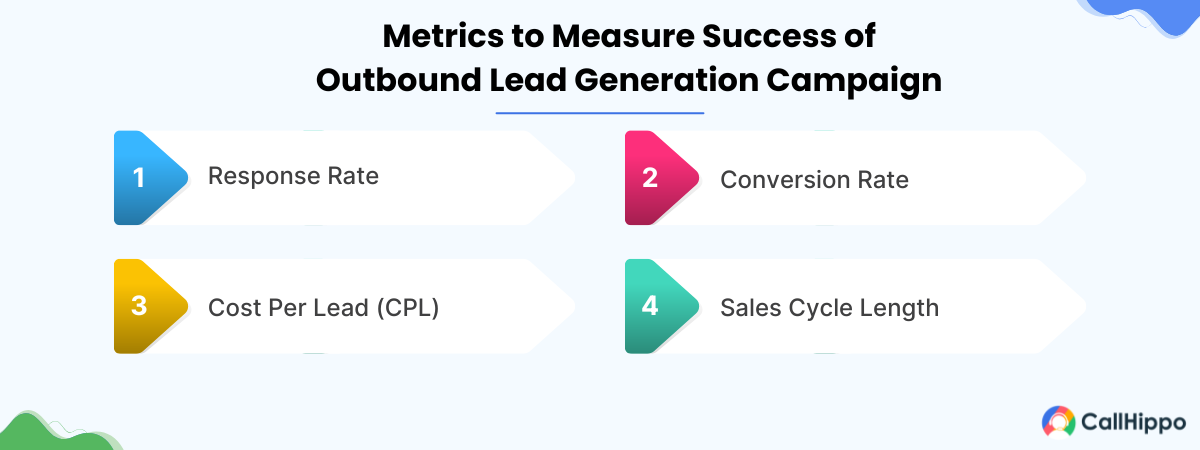
1. Response Rate
The response rate is a critical metric that reflects the percentage of prospects who engage with your outreach efforts. Whether you’re sending cold emails, making phone calls, or sending LinkedIn messages, it’s important to track how many prospects actually respond.
- Response Rate (%) = ( Number of Sent Messages / Number of Responses )×100
A low response rate could indicate that your outreach messages are not resonating with your audience, or that you may not be targeting the right leads. Improving your response rate might require refining your messaging, personalizing your outreach, or better identifying your target audience. This metric helps you gauge the effectiveness of your outbound lead-generation strategies and outreach techniques.
2. Conversion Rate
The conversion rate is the percentage of leads that move from the initial outreach phase to becoming paying customers. This is one of the most important KPIs for any sales process because it directly correlates with the success of your outbound lead generation efforts.
- Conversion Rate (%) = ( Total Number of Visitors or Leads / Number of Conversions )×100
A high conversion rate means your outreach is attracting the right prospects, your messaging is resonating, and your sales team is effectively nurturing and closing deals. If your conversion rate is lower than expected, it might indicate that your leads aren’t qualified enough or your sales process needs to be optimized. Improving this rate can significantly impact your revenue.
3. Cost Per Lead (CPL)
Cost per Lead (CPL) measures the average amount spent to acquire a single lead. This metric is vital for evaluating the efficiency of your outbound campaigns and determining if your marketing budget is being spent wisely. By dividing your total marketing expenses by the number of leads generated, you can understand whether your strategies are cost-effective.
- CPL = Total Number of Leads Generated / Total Campaign Cost
A high CPL might suggest that you’re spending too much on outreach methods that aren’t delivering the desired results, while a low CPL may indicate that your campaigns are running efficiently. Keeping an eye on this metric helps ensure that your outbound lead generation process remains within budget while achieving desired outcomes.
4. Sales Cycle Length
The sales cycle length measures how long it takes to convert a lead into a paying customer from the initial outreach. This metric is crucial for understanding the efficiency of your sales process.
- Sales Cycle Length = Number of Deals Closed / Total Time to Close All Deals
A long sales cycle can indicate that there are bottlenecks or inefficiencies in how leads are nurtured and progressed through the sales funnel. Ideally, you’d want to shorten the sales cycle without compromising the quality of your relationships with prospects.
Tracking this metric allows you to pinpoint areas in your process that may need improvement, such as lead qualification, follow-up strategies, or objection handling. Shortening your sales cycle will enable your sales team to close more deals in less time.
Final Thoughts
Outbound lead generation continues to be a vital strategy for businesses looking to grow in 2024. By using proven outbound lead generation strategies, leveraging AI tools, and tracking performance metrics, you can create scalable and predictable sales pipelines.
Whether you’re running outbound call center lead generation campaigns or refining your outbound lead generation process, staying adaptable and data-driven is crucial for long-term success. Embrace these strategies today to unlock new growth opportunities for your business.

Subscribe to our newsletter & never miss our latest news and promotions.









